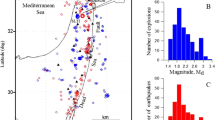Abstract
The spectral time method is applied to the identification of underground nuclear explosions (UNEs) and earthquakes from P wave records obtained at stations at epicentral distances of 15°–40°. It is necessary to utilize data at such great distances because the density of stations of the International Monitoring System is small in several areas of the Earth. At such distances, it is difficult to detect S and surface LR waves and, therefore, the efficiency of the identification using the diagnostic parameters (discriminants) S/P and LR/P is drastically reduced. As a result, the role of spectral and spectral time methods in the identification of events from P waves becomes much more significant. An advantage of the spectral time method (STM) is that it is applicable in the region of interest, provided that data from one or two reference underground chemical explosions and a representative sample of earthquake records obtained at network stations of the region are available. Moreover, in the majority of cases, the STM identifies earthquakes that could not be recognized with the use of spectral diagnostic parameters. We used records of UNEs and earthquakes in Central Asia received from the archives of the Center of the Incorporated Research Institution for Seismology (IRIS) in Washington, the National Data Center in Dubna (Russian Federation), and the International Data Center (IDC) in Vienna. The effectiveness of earthquake record selection using the given method amounted to about 80%. Supposedly, the application of this method of identification can increase the percentage of filtration (screening) of regional events having a natural origin.
Similar content being viewed by others
References
B. Barker, M. Clark, P. Davis, et al., “Monitoring Nuclear Tests,” Science 281(5385), 1967–1970 (1998).
O. Dahlman and H. Israelson, Monitoring Underground Nuclear Explosions (Elsevier, New York, 1977).
A. Dziewonski, S. Block, M. Landisman, and Y. Sato, “A Technique for the Analysis of Transient Seismic Signals,” Bull. Seismol. Soc. Am. 59(1), 427–444 (1969).
W. Hanka, “Analysis of Broadband Rayleigh Waves: A Possibility for Seismic Discrimination,” J. Geophys. 52, 165–179 (1982).
M. A. H. Hedlin, B. Minster, and J. B. Orcutt, “An Automatic Means to Discriminate between Earthquakes and Quarry Blasts,” Bull. Seismol. Soc. Am., No. 6, Part B, 2143–2160 (1990).
O. K. Kedrov, “Basic Scientific and Technical Principles of Monitoring Nuclear Test Ban,” in Conference on Nuclear Test Ban Verification, Linköping, Sweden, May 17–19, 1988, pp. 34–44.
O. K. Kedrov, “Scientific and Technical Prerequisites for Monitoring the Nuclear Test Ban,” in Multidisciplinary Investigations of Physics of the Earth (Nauka, Moscow, 1989) [in Russian].
O. K. Kedrov, “A Method for the Seismological Calibration of the International Monitoring System Using Regional Discriminants,” Dokl. Akad. Nauk 380(3), 390–395 (2001).
O. K. Kedrov, Seismic Methods of Monitoring Nuclear Tests (Moscow, 2005) [in Russian].
O. K. Kedrov, V. A. An, V. A. Laushkin, et al., “Methods of Monitoring Underground Nuclear Explosions from Seismic Data at Epicentral Distances of More Than 500 km,” Izv. Akad. Nauk SSSR, Fiz. Zemli, No. 12, 31–46 (1990).
O. K. Kedrov and E. I. Lyuke, “Recognition of Nuclear Explosions and Earthquakes in Eurasia from Seismic Data at Regional Distances,” Fiz. Zemli, No. 9, 52–75 (1999) [Izvestiya, Phys. Solid Earth 35, 737–759 (1999)].
O. K. Kedrov, E. I. Lyuke, V. E. Permyakova, and A. V. Derov, “The Effect of the Seismic Signal Propagation Conditions on the Efficiency of Recognition of Underground Nuclear Explosions and Earthquakes at Regional Distances,” Fiz. Zemli, No. 7, 32–57 (2001) [Izvestiya, Phys. Solid Earth 37, 556–580 (2001)].
O. K. Kedrov and E. O. Kedrov, “Identification of Seismic Events at the Talgar Station with Regard for Source-Receiver Traces,” Fiz. Zemli, No. 12, 14–22 (2003) [Izvestiya, Phys. Solid Earth 39, 974–981 (2003)].
A. V. Lander, A. L. Levshin, and V. F. Pisarenko, “On the Spectral Time Analysis of Oscillations,” in Computational Seismology (Nauka, Moscow, 1973), Issue 6, pp. 236–249 [in Russian].
V. F. Pisarenko and T. G. Rautian, “Statistical Classification Using Several Criteria,” in Computer-Assisted Interpretation of Seismic Waves (Computational Seismology, Issue 2) (Nauka, Moscow, 1966), pp. 150–182 [in Russian].
Author information
Authors and Affiliations
Additional information
Original Russian Text © E.O. Kedrov, O.K. Kedrov, 2006, published in Fizika Zemli, 2006, No. 5, pp. 47–64.
Rights and permissions
About this article
Cite this article
Kedrov, E.O., Kedrov, O.K. Spectral time method of identification of seismic events at distances of 15°–40°. Izv., Phys. Solid Earth 42, 398–415 (2006). https://doi.org/10.1134/S1069351306050041
Received:
Issue Date:
DOI: https://doi.org/10.1134/S1069351306050041




